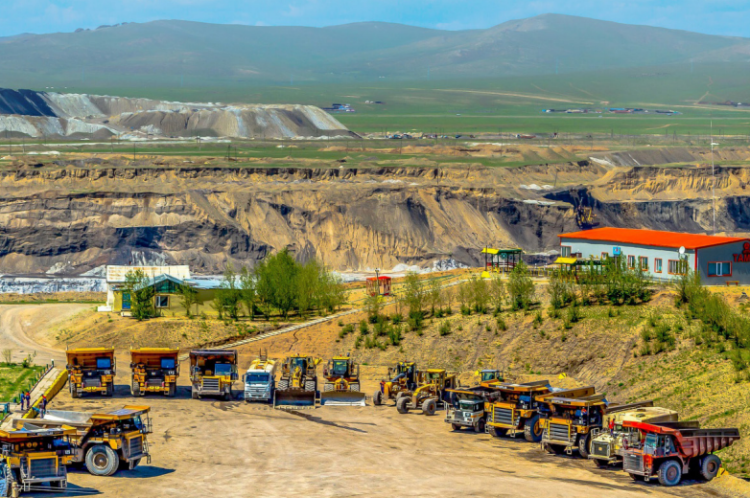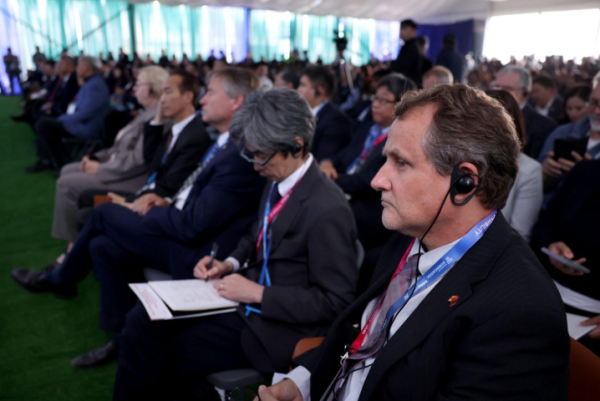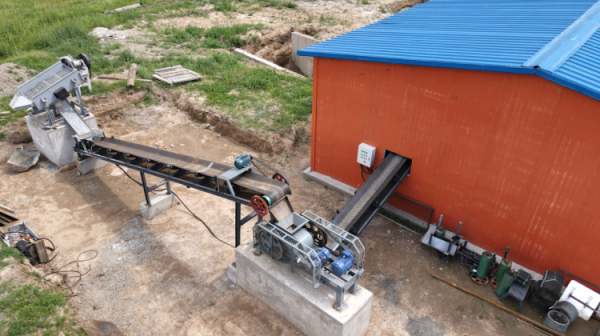An investigation into the corruption risk associated with decision-making in Mongolian mining sector was undertaken. The research, titled "Assessment of Corruption Risk Regulation in Mining sector Decision-Making," was led by Borgil. S and Munkhtogtokh. B, and supported by the Natural Resources Governance Institute (NRGI). In addition to recognizing risks within extractive industry project operations, the study incorporated recommendations for risk mitigation into Mongolia's EITI work plan. "We aimed to approach our research innovatively and distinctively, departing from established methodologies. The investigation encompasses decision-making processes within four key domains: Licensing, Local Cooperation Agreements, Mining Operations Plan Reports, and Environmental Impact Assessments (EIA). Lead researcher Borgil. S underscored the identification of corruption risks inherent in each of these stages, coupled with the formulation of suggestions and recommendations, bolstered by pertinent illustrations. Beyond the tangible corruption risks, it is imperative to discern potential challenges like ambiguity, procrastination, compromised environment, regulatory dependence, and unstructured framework. The study's purview extended to encompass derivative deposit exploitation and artisanal mining, although these aspects are not covered in the report." The decision-making procedures of government entities across the four primary phases of mining projects—Exploration, Pre-Operation, Operation, and Post-Operation—have been meticulously examined within the context of prevailing laws and legal structures. In pursuit of this, concrete instances featuring corruption risks are presented as illustrative examples.
EXPLORATION PHASE:
This stage is subdivided into distinct segments Survey, Site Selection, Exploration Permit, and Exploration Work. Mongolia regards geological exploration as a sector primed for potential foreign investment. From 2015 to 2022, a total of five governmental decrees have been issued concerning field allocation arrangements. The issuance of exploration licenses and the allocation of fields are procedures governed by a non-company-dependent mechanism. These activities transpire exclusively between state administration, local authorities, and the Citizens’ Representative Council (CRC). The division of fields adheres to the regulations outlined in Article 17 of the Minerals Law and the "Licensing Selection Procedures" ratified through Ministerial Order No. A/67 dated April 22, 2022. According to prevailing legislation, during the determination of exploration territories, the state administrative body or MRPAM notifies the governor of the respective province or capital city, with the governor subsequently seeking the input of the CRC. The presented study diagram illustrates a direct reliance on the CRC for the decisionmaking process. The chief risk at this juncture is that, before the response from the CRCs of the province and soum, the area is designated for specific local utilization as prescribed in Article 4.1.13 of the law. An actual case of this was included.
At the local level, comprehensive regulations outlining the decisionmaking procedures of the Governor and the CRC are lacking, as well as the rationales for approval or rejection, as per the Minerals, Administration, Territorial Units, and their Management Laws. Consequently, due to vested interests, the prospect of corruption risk is plausible, arising from potential delays at the government organization decision level during the exploration phase. This scenario leads to ambiguity and time loss. The Procedures of Licensing were studied within the frames of Sections 17, 18, and 20 of the revised Minerals Law (January 06, 2023) examined in conjunction with the “Procedures of the Selection of Licensing” ratified by Order No. A67 of the Minister of Mining and Heavy Industry (April 17, 2022), and “Amendments to the Procedures” by Order No. A/275. Over the past eight years, the "Licensing Selection Procedure" has undergone four amendments and has been re-approved thrice. Despite incremental advancements stemming from these alterations, the process of selection announcements and commission establishment has regressed. For instance, in alignment with the procedure authorized by the Minister of Mining and Heavy Industry, the composition of the selection commission is sanctioned by the same Minister.
This entails a comprehensive delineation of the commission's rights, responsibilities, and compositional prerequisites. However, the amendment to the Minerals Law (January 06, 2023) stipulates that the "composition of the selection commission" requires approval solely from the Minister, with no specific detailing of the commission's powers, duties, operational protocols, or compositional prerequisites. A situation where the selection commission's composition is exclusively designated by a political authority risks neglecting the inclusion of professional representatives. The absence of legislative criteria for composition creates an environment conducive to corruption, as external oversight is absent, enabling individuals with vested interests to wield undue influence over decisions. Consequently, the study's recommendations address the need to clarify the composition criteria for the selection commission. This involves the inclusion of representatives from professional associations, independent experts, researchers, and external oversight entities. Furthermore, there is a call for transparent disclosure of the rationales behind commission member appointments, thereby fostering transparency and accountability in the decision-making process. The subsequent illustration pertains to the 2022 regulation, specifically "Article 2.4," which mandates the unit overseeing Cadastre matters within MRPAM to publish invitations for the selection of all fields finalized as per regulation 2.3. This publication is to occur within the first quarter of each year, followed by selection procedures per Article 17.4 of the Law on Minerals. The notice is required to be disseminated through national daily newspapers and various media channels, at least a day in advance. However, alterations to the regulations within 6 months led to the removal of the phrases "all completed fields" and "within the first quarter of each year."
Consequently, there exists ambiguity regarding the extent of the area, the recipients of the announcement, and the timeline for such disclosures. This ambiguity introduces an inequality where those with proximity to information gain an advantageous position. This scenario creates a foundation for potential bribery, as individuals seek to acquire insights into the selection process through interactions with responsible officials or authorized personnel. Exploration activities after securing a special license for mineral exploration are subject to regulation as stipulated by Articles 31-38 of the Minerals Law. Furthermore, the instructions detailed in Order No. A/22 of 2016, issued by the Head of MRPAM, regarding the "Submission and Acceptance of Exploration Work Plans and Reports" and the oversight of the minimum cost of exploration work, were examined within the scope of verification guidelines. Within 30 days following the acquisition of the license, the holder of the special exploration license is required to endorse the "Environmental Protection Plan" in consultation with the respective Soum Governor. This plan encompasses additional proposals that undergo approval, with modifications being sanctioned by the governor. Research highlights a significant absence of comprehensive provisions within the law for the Soum and District Governors to either approve or reject the "Environmental Protection Plan." The practice of unilateral decision-making by the governor, who may not necessarily represent environmental professional organizations, poses a potential risk. This approach may result in decisions being made arbitrarily, accompanied by the imposition of conditions on the exploration conduct. To counter this, the study recommends that governors at all hierarchical levels leverage insights from professional organizations to form the foundation for their evaluation of the "Environmental Protection Plan." In instances where deliberate delays or unjustified denials lead to financial losses for exploration license holders, the research suggests integrating legal provisions that facilitate the recovery of payments from culpable entities.
PREPARATION PHASE PRIOR TO OPERATION:
The core legal framework governing activities preceding exploitation falls within the scope of Articles 24-27 of the Minerals Law, coupled with regulations endorsed by the Ministry of Mining and Heavy Industry. Within this study, the groundwork leading up to operational activities was explored, encompassing collaboration between the licensee and local governmental entities. As outlined in Article 9.1.10 of the Law, the Cooperation Agreement model to be entered into by the licensee with the local administrative organization has received governmental approval. However, the absence of detailed regulations has led to the establishment of contracts in alignment with the "Model Contract for Infrastructure Development, Employment in Environmental Protection, Mining Utilization, and Factory Establishment," ratified by Government Resolution No. 179 of 2016. This is evident in the contracts archived within the Minerals Contracts Database. An element of uncertainty pervades these contracts, marked by the absence of defined timelines for the work and the lack of specified figures regarding workforce or earnings to be allocated to Soum citizens.
The provisions, intended to facilitate local employment, often remain vague, featuring broad objectives like "providing support," "establishing conditions," and "creating an enabling environment." The contracts alsolack uniform nomenclature and standardized models, a shortcoming attributed to limited public involvement in contract oversight and the assessment of planned activities. The absence of regulations ensuring accountability further compounds these challenges, as observed in the study. Given the absence of standardized requirements, contracting parties formulate agreements based on their interests. A lack of robust monitoring and accountability mechanisms further obstructs the assessment of contract implementation. Despite several amendments to the Minerals Law and the approval of numerous regulations by the relevant Minister, a notable absence exists in terms of updated or enhanced regulations governing local interactions. This, as asserted by researchers, has resulted in an unstructured atmosphere devoid of political backing and a commitment to refining the existing cumbersome framework. The absence of explicit mention of the Local Development Fund (LDF) within the law has led license holders to incline towards evading contractual responsibilities by making financial contributions to the fund during the signing of agreements with local communities. Pursuant to the research recommendations, the comprehensive regulatory process for the execution of Article 42 within the Minerals Law should receive endorsement through a resolution from the Government. Essential and specific prerequisites, vital conditions, and collaborative measures outlined in agreements with local communities ought to be incorporated into the law.
Moreover, consistent reporting of the execution and outcomes of contracts recorded in the Mineral Resources Contract Database is imperative. It was deemed imperative that any contract not entered into the database would render the contract null and void, prompting the imposition of accountability on officials and the imposition of fines on legal entities involved. Such measures serve to mitigate the risk of corruption effectively. A process scrutinized within the pre-commissioning phase is Mine Acceptance. The study's findings highlight that this process lacks complete legal formalization within Mongolia, primarily attributed to the absence of legal delineation concerning the authorities, duties, and responsibilities of the Mine Acceptance Commission. The duration for which the State Commission's decision is awaited remains uncertain. Under the new protocol, the composition of the commission has been streamlined to encompass 3-5 members. However, a commission of limited members brings forth the risk of unregulated and nontransparent decision-making, potential collusion among members, and undue influence exerted upon license holders. Instances corroborating these conclusions are embedded within the study. An illustrative example involves an industrial accident that transpired after the State Commission took charge of a mine located in the Gurvantes soum area of Umnugovi province. This accident resulted in significant environmental harm. While a criminal investigation was initiated, the case was eventually closed due to the absence of criminal intent. Notably, the appointed expert assigned to the case had previous ties to the mine acceptance commission. This expert's assertion, which absolved the Commission from any connection to the incident, underscores a deficiency in legally defined authorities, duties, and responsibilities of the Commission.
OPERATIONAL PHASE:
This stage encompasses various facets of operations, including excavation, mining, processing, transportation, contracting, and sales. The study's focus is bifurcated into two parts: the In-Use Report, Plan, Evaluation, and the Renewal of the Operating Permit. Notably, the information of licensees who fail to furnish mining reports and plans remains undisclosed. The electronic system also lacks pertinent information regarding penalties imposed on license holders for violations, the submission of reports, and the execution of plans. The existence of formalized regulations concerning the quality and assessment of mining and concentrator reporting plans falls short of addressing these concerns. To address these limitations, the study proposes a pivotal shift towards enhancing progress and transparency through the online transfer of functions related to report plan reception, monitoring, and verification.
Consequently, a gap exists in terms of regulations about the disclosure, review, and accountability of mining reports and plans. Article 66.3 of the Minerals Law asserts that "a licensee who repeatedly contravenes applicable laws and mining safety regulations shall be subject to a two-month suspension from prospecting, exploration, and mineral exploitation activities. If the infringement remains unaddressed within this stipulated period, the license will be revoked as per Article 56 of this law." As per Article 21.2.4 of the Subsoil Law, "subsoil usage rights shall be terminated in the event of a severe breach of other regulations governing subsoil use and protection." Consequently, a more intricate set of regulations is imperative. These regulations should encompass not only the accountability of companies for law infringements but should also extend to companies failing to furnish mining reports and plans, along with those recurrently contravening pertinent legal statutes.
POST-OPERATIONAL PHASE:
Within the context of the post-operational phase, the scope was limited to the study of mine closures. Pertinent activities tied to mine closure are governed by the provisions outlined in Article 10.1.14 of the Minerals Law, Sections 27.1.12, 27.1.13, and 39.4 of the same Law, and 8.4.6, 9.11, 9.12, and 14.1.3 of the Environmental Impact Assessment (EIA). In compliance with legal stipulations, license holders are mandated to distinctly specify the necessary funds for mining product transportation, infrastructure establishment, rehabilitation, and closure within the deposit's feasibility study. Moreover, the "Basic Requirements for Feasibility Study of Mining Projects and Feasibility Study Procedures," ratified by the Minister of Mining and Heavy Industry, underline the inclusion of mine closure plans, cost estimates, and post-closure monitoring in the feasibility study. However, neither the law nor regulations provide for financial guarantees concerning mine closure. As per the Minerals Law, closure-related activities should be initiated one year before the event, with a "rehabilitation and closure management plan" submitted to the EIA three years before closure.
This approach deviates from international best practices, which advocate for closure planning from the mine's discovery stage. Furthermore, a mechanism for identifying and addressing socio-economic concerns in the mine closure plan is absent. Although the licensee is legally obligated to engage in agreements with local administrative bodies regarding environmental preservation, infrastructure development, and job creation, this engagement is often isolated from the mine closure plan and lacks synchronization. The survey underscores a critical concern: the transference, seizure, return, or cancellation of the special license may undermine rehabilitation and closure efforts. The lack of cohesion in legal regulations surrounding mine closures poses a risk, allowing licensees to potentially evade closure and rehabilitation responsibilities during exploration and exploitation phases. The research concludes that a distinct trend has emerged in Mongolia, marked by a prevalent inclination to obtain licenses for areas that have been under exploration for the past three decades.
These licenses are often sought with the intent to either sell them to future investors or leverage them as collateral, thereby transforming them into investment sources for raising funds. This practice has led to a form of license bargaining, prompting adjustments in response. One notable adaptation pertains to the method of acquiring exploration permits. Previously obtained through direct application by the candidate, this process has transitioned to an electronic framework, with issuance now occurring through a selection procedure. This transformation has been deemed an advancement over prior practices, contributing to a reduction in bureaucratic hurdles and a heightened level of digitization. In recent years, the mining industry has undergone a perceptible shift towards a greater emphasis on exploitation activities. However, this transition has highlighted a notable lag in the regulatory alignment of the Minerals Law. While the law's three chapters duly address the phases of mineral exploration and extraction, it lacks provisions governing processing, transportation, and sales. Consequently, a comprehensive legal framework detailing the local execution of processing and transportation operations, the resolution of environmental concerns, and the management of local relations remains absent. Simultaneously, contemporary concepts such as public oversight, digitization, and transparency have found a broad reflection in legal documentation. Nevertheless, the laws pertinent to the industry present irregular and inconsistent regulatory clauses. This unstructured regulatory landscape creates avenues for authorities and landowners to make decisions rooted in their discretion, inclinations, and vested interests. The persistent presence of the aforementioned issues raises public suspicions that certain interests might be surreptitiously influencing matters in the background, given the lack of tangible change or resolution. At present, the mining sector contributes 15 percent of Mongolia's GDP and encompasses over 90 percent of total exports.
As the primary economic sector has progressed, the state's involvement in mining activities has expanded, leading to an increase in the number of sector participants and, consequently, an escalated risk of corruption. Paramount to attracting foreign investment is the assurance of transparency andopenness throughout all stages of a mining project. A fundamental prerequisite is the establishment of a stable legal framework that instills confidence in investors. In light of this, the Research Team proposes that proactive measures can be undertaken to counteract corruption. This involves a comprehensive exploration of corruption risks spanning every phase of a mining project, commencing from initial planning and culminating in mine closure. By systematically scrutinizing these phases, the team aims to mitigate corruption risks and uphold the integrity of the mining sector. In 2020, EITI Mongolia embarked on the development of a comprehensive manual aimed at diagnosing corruption risks within the extractive sector. The Ministry of Mining and Heavy Industry has extended its endorsement for the trial implementation of this manual. Subsequently, in 2021, the Sub-Working Group, operating under the EITI Mongolia, was formed with a tripartite representation that includes the AntiCorruption Agency, the Ministry of Mining and Heavy Industry, "Transparency International," and companies affiliated with the "Mongolian Coal Association”. Within this sub-working group, a collective decision was reached to entrust an external team of researchers with the responsibility of conducting a comprehensive study concerning corruption risks within the decisionmaking process of mining projects in Mongolia. The latest standard was ratified during this year's international EITI conference convened in Dakar, Senegal. This new standard incorporates provisions addressing anti-corruption measures.
























